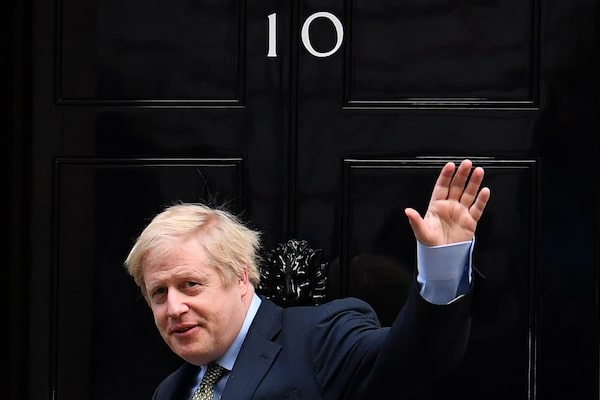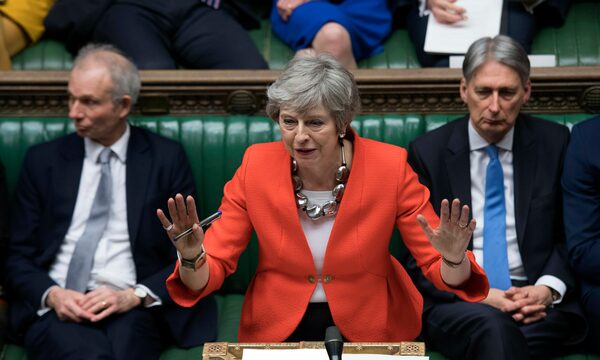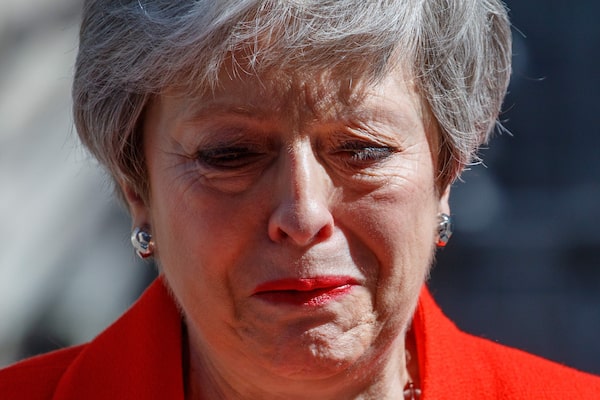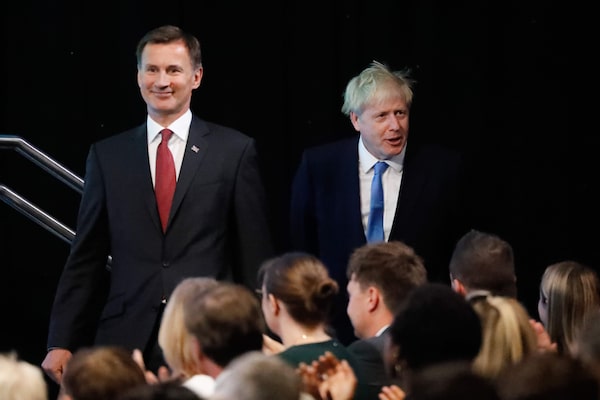
London, Dec. 13, 2019: Prime Minister Boris Johnson arrives at 10 Downing St. in central London after an audience with Britain's Queen Elizabeth II at Buckingham Palace, where she invited him to become Prime Minister and form a new government after the previous day's election.BEN STANSALL/BEN STANSALL/AFP via Getty Images
Britons had their say on the future of Brexit in Dec. 12′s election, and gave Boris Johnson’s Conservatives a majority government that will allow them to press ahead with plans to take Britain out of the European Union. Now, Mr. Johnson has until Jan. 31, the EU’s latest deadline, to agree to a plan, but now that the Conservatives’ seat count far surpasses the other parties, Mr. Johnson has a freer hand to make that happen. Here’s what you need to know.

BRITISH GENERAL ELECTION RESULTS
650 of 650 declared - Dec. 13, 16:30 GMT
326 for majority
Conservative
SNP
LABOUR
365
48
203
Other: 15
Lib Dem: 11
DUP: 8
SCOTLAND
NORTHERN
IRELAND
ENGLAND
WALES
ENGLAND
CON
345 (+48)
LABOUR
180 (-47)
LIB DEM
7 (-1)
GREEN
1 (–)
SCOTLAND
SNP
48 (+13)
CON
6 (-7)
LIB DEM
4 (–)
LABOUR
1 (-6)
WALES
LABOUR
22 (-6)
CON
14 (+6)
PLAID CYMRU
4 (–)
NORTHERN IRELAND
DUP
8 (-2)
OTHERS
10
Note: The Speaker, Sir Lindsay Hoyle, from the Chorley constituency, is included as 'Other' as he does not take part in votes or follow party discipline.
SOURCES: REUTERS; BBC

BRITISH GENERAL ELECTION RESULTS
650 of 650 declared - Dec. 13, 16:30 GMT
326 for majority
Conservative
SNP
LABOUR
365
48
203
Other: 15
Lib Dem: 11
DUP: 8
SCOTLAND
NORTHERN
IRELAND
ENGLAND
WALES
ENGLAND
CON
345 (+48)
LABOUR
180 (-47)
LIB DEM
7 (-1)
GREEN
1 (–)
SCOTLAND
SNP
48 (+13)
CON
6 (-7)
LIB DEM
4 (–)
LABOUR
1 (-6)
WALES
LABOUR
22 (-6)
CON
14 (+6)
PLAID CYMRU
4 (–)
NORTHERN IRELAND
DUP
8 (-2)
OTHERS
10
Note: The Speaker, Sir Lindsay Hoyle, from the Chorley constituency, is included as 'Other' as he does not take part in votes or follow party discipline.
SOURCES: REUTERS; BBC

BRITISH GENERAL ELECTION RESULTS
650 of 650 declared - Dec. 13, 16:30 GMT
326 for majority
Conservative
SNP
LABOUR
365
48
203
Other: 15
Lib Dem: 11
DUP: 8
SCOTLAND
NORTHERN
IRELAND
ENGLAND
WALES
ENGLAND
SCOTLAND
CON
345 (+48)
SNP
48 (+13)
LABOUR
180 (-47)
CON
6 (-7)
LIB DEM
7 (-1)
LIB DEM
4 (–)
GREEN
1 (–)
LABOUR
1 (-6)
WALES
NORTHERN IRELAND
LABOUR
22 (-6)
DUP
8 (-2)
CON
14 (+6)
OTHERS
10
PLAID CYMRU
4 (–)
Note: The Speaker, Sir Lindsay Hoyle, from the Chorley constituency, is included as 'Other' as he does not take part in votes or follow party discipline.
SOURCES: REUTERS; BBC
Why Brexit?

June 24, 2016: Newspaper front pages report the exit of prime minister David Cameron after the Yes side's unexpected victory in the Brexit referendum.DANIEL SORABJI/DANIEL SORABJI/AFP/Getty Images
In 2016, then prime minister David Cameron rolled the dice on a referendum about whether to secede from the European Union, and Britons unexpectedly voted yes. Mr. Cameron’s Conservative Party, inherited after his resignation by Theresa May, went to war with itself about how to go forward. On one side was Ms. May’s “soft Brexit” camp, which favoured keeping some ties with Europe and, in particular, a compromise to allow freedom of movement between Northern Ireland, which is part of the U.K., and the Republic of Ireland, an EU member state. On the other side was the “hard Brexit” faction, including her successor Mr. Johnson, which wanted a complete break between Britain and the EU single market.
Ms. May triggered the mechanism to quit the union, Article 50. So now it’s just a question of when Brexit happens and how. Many believe the worst-case scenario is a “no-deal” Brexit, in which there’s no new trade agreement to replace EU membership: That means gridlock at the border, shortages of food and goods and the flight of corporate headquarters from Britain.
Mr. Johnson’s latest agreement with the EU tries to settle the Northern Irish question by keeping the territory in the British customs union, but having British officials enforce European rules and collect the EU’s tariffs for products heading to or from Europe. Customs checks would be done at ports, but not on the Irish land border. Both sides are still aiming for a more comprehensive trade deal later, but if the British Parliament and Northern Irish legislatures agree to it, the no-deal Brexit will be averted. The Democratic Unionist Party, which helped to keep the Conservatives in government under Ms. May, opposes the deal, as does the opposition Labour Party, which wants the deal brought to a nationwide referendum. But in Dec. 12′s election, the Conservatives won a larger-than-expected majority over the other parties, meaning their version of Brexit is the one likeliest to prevail.
How we got here: A timeline
The May deal, Part I

Nov. 15, 2018: European Council President Donald Tusk holds Britain's draft withdrawal agreement with the EU during a press conference in Brussels.EMMANUEL DUNAND/AFP/Getty Images
It takes a year and a half for Ms. May to hammer out the first draft withdrawal agreement with the EU, which is unveiled on Nov. 13, 2018. The deal – a 584-page agreement and a 26-page political declaration – is quickly approved by Brussels, and sets a divorce date of March 29, 2019, but keeps Britain inside the EU single market until the end of 2020. But this deal provokes an angry backlash in Ms. May’s government. The main sticking point is a “backstop” plan to keep Britain in a customs union and avoid the return of a hard Irish border. The Northern Irish-based Democratic Unionist Party, which Ms. May depends on for continued support of her government, opposes the backstop because, while it would leave the Irish border open, it could create impediments for Northern Irish trade with the rest of the U.K. Ms. May survives an exodus of top cabinet ministers and a challenge to her leadership of the Conservative Party, but on Jan. 15 her deal meets a historic defeat: 432 against, 202 in favour, the worst government defeat ever in the House of Commons.
The Brady alternative
MPs vote on an array of seven non-binding amendments to Ms. May’s deal. Most of them are defeated, but two key ones pass. One rejects the prospect of a “no deal” Brexit, in which Britain would leave the union as scheduled without a replacement trade deal. Another – dubbed the “Brady amendment” after the Tory backbencher who introduced it, Graham Brady – gave Ms. May a mandate to go back to the EU and ask for a new deal changing the backstop, which the EU didn’t want to do because they thought the issue had already been settled months earlier. Ms. May seeks Parliament’s support for her negotiating strategy in a non-binding vote on Feb. 14, but she loses 303 to 258. For many Tories, the strategy is no good because she didn’t rule out walking away from talks with the EU and allowing a no-deal Brexit.
The Malthouse compromise
Seeking to find common ground between the hard- and soft-Brexit factions, housing minister Kit Malthouse proposes offering the EU two new options, both of which would extend the departure timeline to December, 2021. Plan A would establish a U.K.-EU free trade deal instead of the backstop; Plan B would be a “managed no-deal Brexit,” which would soften the economic blow of restored trade barriers. One EU official describes the Malthouse compromise as a “bonkers” plan and it doesn’t gain any traction.
The May deal, Part II

March 12, 2019: Prime Minister Theresa May speaks to lawmakers in Parliament.JESSICA TAYLOR/The Associated Press
Ms. May brings a revised version of her deal back to Parliament on March 12 after a new agreement with the EU that would reduce the risk of Britain being stuck in the backstop if no new trade deal was reached. But it isn’t enough to mollify critics of the backstop, and the motion is defeated 391 to 242. A further decision by the House speaker bars Ms. May from bringing back the deal for a third vote, unless she makes substantial changes first. MPs do agree to send Ms. May back to the EU and ask for more time. Her preferred new date for Brexit is June 30, but the EU settles on a tighter deadline: April 12 if Ms. May can’t get her modified withdrawal agreement approved by MPs, and May 22 if she can.
The eight unacceptable options
On March 25, MPs take unprecedented steps to wrest the Brexit file out of the Prime Minister’s hands, voting 329 to 302 to hold non-binding “indicative votes” to weigh support for alternatives. The eight options include a second Brexit referendum, revoking Brexit, staying in the EU customs union, the Malthouse compromise or a no-deal Brexit. In votes on March 27 and April 1, none of the alternative options find a consensus.
The May deal, Part III
Ahead of the third showdown over her Brexit plan, Ms. May promises to quit as Prime Minister if MPs vote for the withdrawal agreement, hoping this will allay critics. On March 29, MPs vote just on the withdrawal agreement, not the political declaration that would lay out the future U.K.-EU relationship. Had the vote passed, Britain would have won the sought-after extension to May 22. Instead, it fails, throwing Britain’s economic future into more chaos.
Delay, delay, delay
After her third defeat, Ms. May is under a tight deadline: Get an extension from the EU by April 12, or allow a no-deal Brexit to happen on that date. She asks the EU to delay until June 30, but after emergency talks they give her even more time: Oct. 31, with a review of the terms in June. The deal, which British lawmakers quickly approve, still leaves room for an exit before October as long as Parliament agrees on it.
No May by June

May 24, 2019: A tearful Ms. May announces her resignation outside 10 Downing St.TOLGA AKMEN/AFP/Getty Images
On May 21, Ms. May brings MPs a fourth Brexit plan, one that allows MPs to vote on whether a second Brexit referendum should be held. She also promises to give MPs a say in whether Britain should stay in an EU customs agreement, and to harmonize EU and U.K. rules on worker’s rights and the environment. But the hard-Brexit camp meets the new plan with skepticism and renews calls for her to resign. Days later, she does just that, promising to step down as party leader on June 7 and saying “it is now clear to me that it is in the best interests of the country for a new Prime Minister to lead” the Brexit effort. She remains prime minister until a new Conservative leader is chosen, a process due to finish by late July.
No-deal a no-no? House says no
With the Conservative leadership well under way, Labour tries to ensure the next prime minister can’t take Britain out of the union without a deal. A June 12 cross-party motion sets aside a future date to craft legislation that would limit the prime minister’s power to choose a no-deal outcome without Parliament, but the motion fails on June 12.
Boris is boss, Part I

July 23: Conservative Party leadership candidates Jeremy Hunt and Boris Johnson (R) arrive in the auditorium at an event to announce the winner of the leadership race.Tolga Akmen/AFP/Getty Images
Through June and July, the Conservative leadership race turns into a two-man standoff between Boris Johnson and Foreign Secretary Jeremy Hunt. Mr. Johnson is bullish on the prospect of a no-deal Brexit: “We will of course be pushing our plan into action, and getting ready to come out on October 31st, come what may … do or die,” he says in a TalkRadio interview in June. On July 23, Mr. Johnson wins the leadership by 92,153 votes to Mr. Hunt’s 46,656. “We are going to engergize the country. We are going to get Brexit done,” Mr. Johnson said at the event announcing the result.
Prorogation, Part I
Mr. Johnson spends his first month in office haggling with European leaders to get them to drop the backstop, but they refuse, saying he has no realistic alternative. On Aug. 28, he asks the Queen to suspend Parliament from mid-September until she opens the legislature on Oct. 14, a request she granted. Short prorogations before a Queen’s Speech are traditional, but the timing is terrible for MPs who are still mostly on vacation and now have one month less in which to challenge Mr. Johnson to delay the Brexit date. Opposition leaders are furious, and Speaker John Bercow calls it a “constitutional outrage.”
The Brexit blocks

London, Sept. 3: Political artist Kaya Mar holds a painting of British Prime Minister Boris Johnson, left, Britain's Queen Elizabeth II, middle, and Speaker of the House of Commons John Bercow as he stands opposite Parliament Square.Matt Dunham/The Associated Press
As MPs return from summer break on Sept. 3, Mr. Johnson threatens an October snap election if they vote to have him seek to delay Brexit once again. On Sept. 4, several Conservative MPs choose to defy him, voting 327-299 to pass legislation that would send the Prime Minister back to the EU to seek another three-month Brexit extension. One MP, Phillip Lee, defected to another party; others – including Nicholas Soames, Winston Churchill’s grandson – were effectively expelled; and Mr. Johnson’s own brother, Jo Johnson, resigns as a Conservative MP, saying he had been “torn between family loyalty and the national interest.” The divisions cost Mr. Johnson his majority, so when he tries to schedule an election date – a move requiring two-thirds support in the House – Parliament turns him down twice. On the evening of Sept. 9, the five-week prorogation begins and Mr. Johnson has no chance of getting the Oct. 15 election he seeks. Despite the legislation requiring him to avert a no-deal exit, he refuses to back down: “I will go to Brussels … and negotiate our departure on the 31st of October, hopefully with a deal but without one if necessary,” he tells MPs. “I will not ask for another delay.”
Prorogation, Part II
Throughout the parliamentary drama, MPs have been fighting the prorogation in court. On Sept. 11, a Scottish court rules that Mr. Johnson’s decision was illegal because “it had the purpose of stymying parliament.” The nation’s Supreme Court concurs two weeks later, ruling that the prorogation is null and void. After consulting with party leaders, Mr. Bercow, the Speaker, says Parliament will resume on Sept. 25. Mr. Johnson, who is away in New York for a United Nations summit, disputes the court’s decision but accedes to Parliament’s return. He also rejects calls for his resignation.
The Johnson deal, Part I

A letter dated Oct. 19, written by Mr. Johnson and addressed to the European Council President Donald Tusk, asks the European Union for another Brexit delay.Downing Street/The Associated Press
As instructed by Parliament, Mr. Johnson goes back to the EU with a new proposal. On Oct. 2, he announces a plan – which he describes as his final offer – that takes Northern Ireland out of the EU customs union but sets up a different regulatory regime whose agricultural and product standards are aligned more closely with its EU neighbour. Negotiations break down over the following week, with Mr. Johnson and his EU counterparts blaming each other. Then on Oct. 17, Mr. Johnson and European Commission leader Jean-Claude Juncker announce a breakthrough: A 64-page revision to Ms. May’s original deal. Mr. Johnson announces he plans to bring the plan to a vote on Oct. 19. But Labour and the DUP oppose the agreement, and at a special session of Parliament, MPs vote 322-306 to hold off on even considering it until after Mr. Johnson introduces a legislative framework for implementing it. As per the legislation passed in September (see “the Brexit block,” above), Mr. Johnson begrudgingly sends a letter to the EU asking for another three-month Brexit extension.
From Brextension to Brelection
On Oct. 28, the EU announces another three-month extension, resetting the Brexit date to Jan. 31, 2020. By this point, the impasse between Mr. Johnson and Parliament is still unresolved: Mr. Johnson tries to call a snap election, but loses because Labour abstains, saying it wants assurances first that Britain will not leave the EU without an agreement on Oct. 31. Mr. Johnson reluctantly accepts the EU’s extended deadline, and with the immediate threat of a no-deal Brexit removed, Labour drops its objection. Parliament votes on Oct. 29 to have an election on Dec. 12.
London, Dec. 13: Jeremy Corbyn leaves the Labour Party's headquarters after the general election.Henry Nicholls/Reuters
Boris is boss, Part II
The Conservatives fight in the December election under the slogan of “Get Brexit Done,” while Labour promises to hold another referendum on Brexit’s future if they are elected. Britons, weary with the now three-year-long Brexit process, give Mr. Johnson a majority as traditional Labour ridings switch sides. The Conservatives win 365 of Parliament’s 650 seats, while Labour wins only 203, its lowest seat count since the 1930s. Mr. Johnson calls it a “powerful new mandate to get Brexit done.”
More reading
Globe and Mail reports from Europe
Brexit is making Irish reunification a real possibility
Fearing Brexit doomsday, Britons stockpile supplies and learn to grow their own food
In the English town that pottery built, workers fear Brexit will shatter a way of life
Commentary and analysis
Editorial: How bad is Boris Johnson? We can’t even find the words
Barry Campbell: Does Brexit spell the end for the Mother of Parliaments?
Ian Buruma: In the Brexit mess, where does the will of the British people truly lie?
Simon Usherwood: British short-termism is going to be a long-term problem
Niall Ferguson: Jo Johnson’s resignation reminds us how fraternity can turn to enmity
Compiled by Globe staff
With reports from Paul Waldie, Associated Press and Reuters